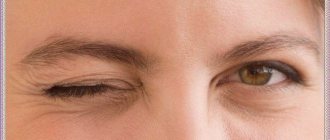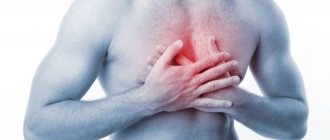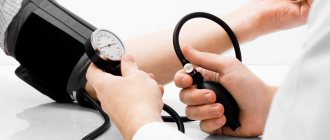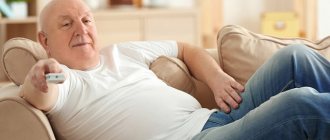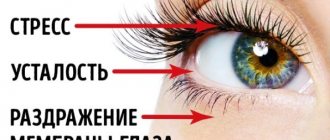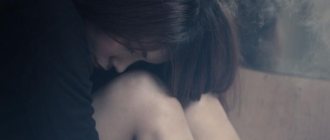In the evening after work we rush home. The day, as usual, was difficult: meeting and communicating with many people who were not always pleasant for us, running around accompanied by hassle, rush jobs, conflicts with management, etc. Home is our quiet haven, where you can relax, unwind, and throw off the burden of fatigue and daytime negativity. And so, after a delicious dinner, we sit in our favorite cozy chair or lie on a comfortable sofa. The TV flickers as usual, on the screen of which the heroes of the next series are saving the world, we fall into a slumber... And suddenly a sharp jolt, from which our legs tremble, forces us to wake up. Similar sensations occur from electric shocks. A familiar picture, isn't it? Where does this push come from, and why do your legs twitch when falling asleep?
Myoclonus: signs and characteristics of the syndrome
In medicine, the phenomenon of startling during sleep, in which involuntary sharp muscle twitches occur, is called nocturnal myoclonus. When the body reaches its greatest level of relaxation, active muscle contractions may occur, which is called positive myoclonus.
The appearance of a similar syndrome is also possible when muscle tone decreases. In this case, myoclonus is called negative. The described syndrome also has an alternative name - hypnagogic startle.
Myoclonus can affect local areas of the body, for example: only the right leg or even one of the leg muscles. In more complex cases, all limbs can twitch, sometimes even the facial muscles responsible for facial expressions. Based on the nature of myoclonic seizures, they are classified into rhythmic, arrhythmic, reflex, spontaneous, asynchronous, synchronous.
What is the essence of myoclonus? The brain is the control panel of the body. The movements of each part of the body are provided by certain muscle groups. To begin movement, muscle tissue must receive a corresponding signal from the brain, which arrives through the channels of the nervous system. The result of such signals is the excitation of muscle fibers with subsequent contraction of muscle tissue. If for some reason there is a simultaneous excitation of a whole group of channels of the nervous system, then a shuddering of the body or its individual parts begins. This phenomenon is called myoclonic spasms.
The hypothalamus is to blame for everything
In the intermediate part of the brain there is a section called the hypothalamus. This area is formed by a large number of cell blocks and is responsible for the normal functioning of many body systems. For example: it regulates metabolic processes, controls the endocrine, cardiovascular, and also controls the autonomic and many other systems. When a person falls asleep, the first phase of sleep begins, a decrease in body temperature and a drop in blood pressure occur. The breathing pattern changes: a significantly smaller volume of air is inhaled into the lungs and exhaled. This whole complex of changes in the body’s performance indicators is similar to the processes characteristic of death.
The hypothalamus regards this situation as dangerous, and in order to “resurrect” the body, return all its systems to an active state, it sends a discharge and creates a shake-up. Result: a sharp increase in muscle tone, expressed in body trembling.
Hypnagogic startle has no age, social or gender restrictions. This syndrome can manifest itself in one form or another in each of us. How can you determine whether you should worry and make an appointment with a neurologist if you notice myoclonic seizures or not? The determining moment is the duration of the startle in sleep. If this phenomenon is short-term, sometimes present in the initial phase of sleep, then there is no need to worry. This level of myoclonus is within the normal range and does not threaten health and proper sleep.
Everything is much more serious if myoclonic spasms accompany sleep throughout the night. This pathology does not allow you to get enough sleep, the body does not recover. Pathological myoclonus indicates significant health problems and can provoke the emergence of new diseases. In such circumstances, it is, of course, impossible to do without qualified medical care. The sooner treatment begins, the more effective its results will be.
Physiological myoclonus
The vast majority of people experience hypnagogic startle. If the manifestations of myoclonus do not last long at the beginning of falling asleep, then they do not pay attention to this. In the morning there are no memories of short-term cramps. Only loved ones can see and tell this.
USEFUL INFORMATION: Why you constantly want to sleep and lethargy: reasons
Among neurologists, one theory of the occurrence of nocturnal myoclonus is most common. It lies in the fact that the brain perceives as a danger the slowdown in the body’s vital processes during the transition to sleep. However, this is not the only opinion; there are several more versions that deserve attention:
- It is possible that myoclonic spasms occur when sleep phases alternate. The sleep process is complex and consists of several phases: slow, fast, shallow and deep sleep. During the transition from one phase to another, a sharp change in brain activity indicators occurs, which provokes the occurrence of impulses in many channels of the nervous system simultaneously. The result of this is the appearance of nocturnal myoclonus.
- Some experts in psychology and neurology are of the opinion that shuddering when falling asleep occurs due to excessive stress on the nervous system. During the day, a person experiences many events, experiencing a lot of different feelings. Negative emotions cause stress. And its accumulation leads to overload of the nervous system, which during sleep seems to “replay” unpleasant situations again.
- Another theory for the occurrence of hypnagogic shudder is an insufficient amount of a trace element such as potassium in the body. It is part of all soft tissues, bones, blood, and its deficiency negatively affects the functioning of the liver, brain, nervous and cardiovascular systems. If tests show that there is little of it in the body, the doctor will prescribe appropriate medications.
- The cause of body trembling when falling into a doze can be a nervous tic, which is a monotonous involuntary rapid contraction of muscle tissue. In children, it usually goes away with age. Adults should undergo a course of treatment that will reduce severe symptoms.
- Myoclonic spasms can be triggered by excessive physical exertion. This is especially true for older people, as well as those who do not have appropriate physical training.
Whatever causes short-term nocturnal myoclonus, such symptoms are not a pathology. If there are signs of physiological myoclonus, then do not panic - they are considered a natural component of healthy sleep.
Patient Questions About Restless Legs Syndrome
My legs twitch when falling asleep, what should I do?
If your legs twitch when falling asleep, you need to figure out the cause of this phenomenon. Convulsive contractions of the muscles of the lower extremities can be caused by a number of reasons. First you need to visit the following specialists: a neurologist and phlebologist. An ultrasound duplex examination of the veins of the lower extremities must be performed. Having understood the cause of the condition, it will be possible to completely get rid of convulsive twitching at night.
How to treat restless legs syndrome?
To understand how to treat restless legs syndrome, it is necessary to find out the cause of its occurrence. This will require consultations with the following specialists: a neurologist, phlebologist and therapist.
My legs twist a lot at night, what should I do?
If you experience severe leg cramps at night, seek medical attention. A very common cause of this condition is chronic venous insufficiency, complicating varicose veins.
Pain in legs at night when lying down, which doctor should I go to?
If you have pain in your legs at night when lying down, the first doctor you should visit is a phlebologist. At the beginning, it is necessary to exclude venous pathology. Perhaps a phlebologist will completely solve your problem.
Pathological myoclonus
If a short trembling of the legs during the transition to sleep should not cause fear and anxiety, then myoclonic spasms during the day during wakefulness are a reason to be concerned. Sometimes, after experiencing serious stress, which necessarily manifests itself in overload of the nervous system, some manifestations of daytime myoclonus are acceptable. If this does not occur chronically and there are no relapses, then there is no cause for alarm yet. However, when the syndrome manifests itself repeatedly during the day, and then it repeats in subsequent days, then, most likely, pathology can be assumed.
The causes of pathological myoclonus can be different. Frequently repeating progressive daytime and nighttime hypnagogic seizures are one of the signs of epilepsy. Moreover, they can affect both local areas and the entire body. Various manifestations can provoke an attack, for example: severe thunderstorms, lightning strikes, loud music with flashing lights. Doctors explain the causes of epileptic seizures as an insufficient amount of oxygen entering the brain, as well as degeneration of brain cells.
There is also an essential variant of myoclonus, which in patients begins in childhood, being a hereditary disease.
In addition to the above, there are a number of conditions against which the symptoms of pathological myoclonus may appear:
- Viral encephalitis. When the virus enters the brain, inflammation begins. The carriers are already sick people or infected insects; sometimes the disease is caused by the herpes simplex virus.
- Diseases affecting the spinal cord, cerebellum, brain stem, which are transmitted hereditarily.
- Storage reticulosis (storage diseases). A complex of hereditary or acquired (acquired) pathological conditions that cause metabolic problems, damage to the cardiovascular or central nervous system.
- Degenerative processes in the basal ganglia, which are located in the white matter of the brain.
- A sharp disturbance in the blood circulation of the brain (stroke). Signs of illness may include sudden fainting or paralysis.
- An inflammatory process in nerve endings that affects fibers. Occurs due to diseases of various internal organs. Damage to nerve fibers can also be the result of poisoning with a toxic substance or an overdose of a medication.
USEFUL INFORMATION: Why do your hands go numb during sleep?
Only specialized doctors can determine the cause of pathological myoclonus. As a rule, if a disease is suspected, an electroencephalogram is prescribed and blood is given for tests. If signs of pathological myoclonus are detected, you should not postpone going to the medical center; advanced diseases are more difficult to treat and take longer.
Restless legs syndrome
One of the manifestations of pathological myoclonus may be restless legs syndrome (RLS). It has alternative names - Ecomb or Willis disease, after the names of the research scientists. Its symptoms are shaking of the legs during the period of falling asleep, which then continues throughout sleep. Cramps usually affect the feet and legs, sometimes only one leg twitches. The discomfort is not limited to trembling. They are accompanied by itching and a constant need to move the legs. The disease can appear not only in older people, but also in fairly young people, even children. Most patients are women. According to statistics, about ten percent of people on the planet suffer from restless legs syndrome. When a neurological examination is performed, it is impossible to identify RLS; only the clinical manifestations of this disease help determine the correct diagnosis.
Restless legs syndrome occurs in two variants: symptomatic and idiopathic, they are treated with different methods:
- Symptomatic RLS appears in a patient due to various diseases of the nervous or somatic system. If the diagnosis is correct and therapy is carried out, then the signs of the syndrome disappear. Possible diseases: rheumatoid arthritis, thyroid disorders, diabetes, anemia, kidney failure. The appearance of symptoms of RLS can also be caused by taking certain medications (antihistamines, anticonvulsants, antidepressants, etc.).
- The idiopathic version of restless legs syndrome appears, one might say, “out of nowhere,” that is, the disease begins suddenly. This type of RLS is inherited, although some coincidence of other factors is required for its symptoms to manifest itself. The disease usually occurs in patients under thirty years of age and cannot be treated; it is only possible to smooth out the symptoms with medications.
A characteristic feature of the treatment of RLS with medications is its duration; therapy takes many years. This requires the need to achieve the greatest effect by taking the smallest doses of drugs. Over time, you get used to the medications, which means you have to increase the dosage. Combinations of drugs should be avoided and limited to monotherapy.
Causes
Biological reasons may be due to the fact that the endocrine glands begin to release large amounts of adrenaline into the blood. This hormone is normally produced in extreme situations that threaten human health or life. It is this that influences the acceleration of all physiological reactions, that is, the heartbeat quickens, the sweat glands and lungs begin to work harder. This is how the body prepares to defend or escape from a mortal threat.
But why does this hormone begin to be released during sleep, when a person is safe and not in danger? The answer to this question is not yet completely clear. Most likely, there are individual psychological reasons here - for example, increased personal anxiety as a character trait: most often, attacks occur in suspicious, emotionally vulnerable and anxious people. It is they who are most prone to self-flagellation and long experiences of life events; and/or negative experience of relationships in the past, in which a person acquired such qualities as distrust, suspicion, lack of internal, psychological permission to relax (“you can’t lose control for a minute, you can’t relax - otherwise something irreparable will happen”).
Provoking factors for panic attacks at night during sleep are:
- Chronic drinking or drinking too much alcohol before bed.
- Severe stress.
- Childhood psychological trauma.
- Hormonal disorders.
- Exhaustion of the nervous system due to constant worries and stress.
- Hereditary predisposition to anxiety disorders.
- Traumatic brain injuries.
- Work activity that involves constant emotional stress or risk to life.
According to statistics, about 50% of people diagnosed with neurosis or vegetative-vascular dystonia suffered from nighttime panic attacks.
Sleep paralysis
Myoclonus can also manifest as sleep paralysis.
Its symptoms have been familiar to people since ancient times, and they are covered in various mystical stories. A patient suffering from this disorder is conscious, but cannot even move. This state is accompanied by increasing panic, fear, and visions. It was the visions that created the mystical infernal flair for this disease. A patient in a state of sleep paralysis sees monsters, aliens, hears otherworldly voices, chilling sounds, etc. The condition is aggravated by a feeling of suffocation and heaviness in the chest area. At the same time, the patient trembles, his pulse quickens, and breathing becomes difficult. Fortunately, all these conditions accompanying sleep paralysis do not threaten your health, but they do force you to endure several very unpleasant minutes. The cause of the manifestations of the syndrome can be various types of diseases of the nervous system. Their range is wide: from manic-depressive psychosis to somnambulism and narcolepsy. Although most often sleep paralysis occurs due to an imbalance in the nervous system.
Possible reasons:
- frequent severe stress;
- drug addiction or alcoholism;
- chronic lack of sleep;
- overdose or many months of taking certain medications (tranquilizers, antidepressants).
In addition to the listed factors for the occurrence of the syndrome, sleep paralysis can be inherited. In most cases, drug treatment is not required. After confirming the diagnosis, doctors recommend changing your daily routine, sleeping at least eight hours a day, leading a mobile, active lifestyle, avoiding stress, giving yourself a massage, etc.
SPDK
Often myoclonus can manifest itself in the form of periodic limb movement syndrome (PLMS). A patient suffering from this disease rhythmically flexes and extends his big toes and ankle joints during sleep. What happens lasts in cycles of twenty to forty seconds. In most cases, such a deviation causes one to wake up, while the patient does not remember the episode. Almost always, periodic limb movements syndrome accompanies restless legs syndrome; the causes of occurrence in SPD and RLS are similar.
USEFUL INFORMATION: Why does my head hurt in the morning after sleep?
What is Restless Legs Syndrome?
Restless legs syndrome is a pathological condition consisting of an obsessive desire to move the legs, caused by a number of certain unpleasant sensations in the lower extremities. These sensations with restless legs syndrome can be pain or aching in the muscles, as well as itching, a burning sensation, crawling distension or twitching in the lower extremities.
Restless legs syndrome
These subjective symptoms more often occur at night or when taking a horizontal body position and relaxing. A significant weakening of the above symptoms occurs with contraction of the muscles of the lower extremities. Therefore, patients with restless legs syndrome have an obsessive need to move the lower extremities.
Symptoms in children
Parents can pay attention to how the baby twitches its legs during the transition to sleep. Don't panic. It should be remembered that the baby’s sleep structure is different from ours. This is explained by age and different stages of development of the body - the older the person, the more complex all the processes. The duration of deep sleep for an adult is two to three hours, while for an infant it lasts approximately one 50-60 minutes. Deep sleep is replaced by shallow sleep, and during this transition the baby may shudder. That is, twitching during the superficial phase indicates that the child is simply dreaming. Myoclonus can also occur in children during adolescence. This period of life is characterized by active reorganization of the body, so sometimes malfunctions in the functioning of the nervous system can occur.
Result of stress
According to this theory, twitching during sleep can occur as a result of stress, anxiety, fatigue, anxiety, etc. They can also be provoked by an uncomfortable sleeping position.
Scientists who adhere to this version believe that the cause of twitching is that a person falls asleep under stress. The brain receives the alarm signal and interprets it as a fall. After which the brain tries to explain the reason for this fall and generates a half-sleep in which the person jumps from a cliff, slips and falls, etc. When a person wakes up, he will remember this dream.
Notably, the most common movements during sleep are eye movements. Our eyes continue to move according to our sleep. So, for example, if we dream of playing ping pong, then our eye movements in real life will correspond to the movements of the ball in our dream. Such eye movements indicate that the person is currently dreaming.
Tom Stafford believes that hypnogogic seizures indicate that the motor part of the nervous system continues to some extent control the body, while sleep paralysis begins to take over it.
Tom Stafforth also suggests that the startle associated with dreams of falling is an example of a rare phenomenon in which external stimuli during sleep become part of the dream. This demonstrates the amazing ability of the human brain to create plausible stories to explain the data obtained.
Hypnogogic convulsions are evidence that we still know very little about the functioning of our amazing brain and that behind this veil there are still many secrets that scientists will have to uncover in the future.
Prevention and treatment methods
If you discover symptoms of hypnagogic startle in yourself or your loved ones, there is no need to panic. Medicine has sufficiently studied this disease, so there are a number of effective methods for getting rid of it.
If myoclonus is pathological, then you will have to undergo a course of drug therapy that will help eliminate the disease that causes seizures.
If it turns out that myoclonus is of a physiological type, then a set of the following measures will help get rid of it:
- First of all, you need to develop a daily routine and try to stick to it. You need to train yourself to go to bed early and wake up earlier in the morning, preferably with an alarm clock. The duration of sleep should be at least eight hours, if this is not enough - nine or ten hours.
- Complete cessation of bad habits. Alcoholism, drug addiction, and smoking are some of the main causes of myoclonus.
- Active lifestyle, sports activities. A light warm-up in the morning and a run in the fresh air will quickly bring results. If you can’t run, you should try to walk more.
- Avoiding large doses of caffeine. If you are a fan of strong tonic drinks (coffee, tea), you should significantly reduce their consumption due to the stimulating effect of caffeine. Replace your usual drink with fruit compote or chamomile tea.
- Inclusion in the diet of foods containing magnesium, calcium, potassium (kefir, vegetables, herbs).
- In autumn-winter, hypothermia should be avoided; you should especially try to keep your hands and feet warm.
- Avoid activity the night before bedtime. You can take a warm bath, light scented candles, and turn on calm music.
- Creating comfortable sleeping conditions. It is unacceptable to use old bedding, especially pillows with bird feathers. You should purchase an orthopedic mattress and pillow. Loud noises and bright lights should not interfere with falling asleep.
- Control the microclimate in the bedroom. The room must be ventilated and monitor the normal level of air humidity. If the air is dry, especially during the heating season, then it is advisable to buy a humidifier.
The measures listed above will help you regain restful sleep. All these actions are recommended for those who do not experience manifestations of myoclonus - this will be an effective prevention of the disease. A restful sleep will allow you to recover after a difficult day and give you new strength to achieve your goals.
Treatment for restless legs syndrome
Taking multivitamins, anticonvulsants, and giving up bad habits often help get rid of restless leg syndrome.
Restless legs syndrome is a fairly common complaint in patients suffering from varicose veins for a long time. Chronic venous insufficiency, which occurs with varicose veins, disrupts the electrolyte balance in the tissues of the lower extremities, leading to the appearance of restless legs syndrome. This condition is well known to many patients with varicose veins. In some cases, wearing compression stockings may help, providing some relief. However, after some time, restless legs syndrome returns. Only radical treatment of varicose veins helps patients completely get rid of restless legs syndrome.
Restless legs syndrome is not a symptom exclusively of varicose veins. There are many other causes of restless legs syndrome. It is very likely that a therapist or neurologist will be able to help. However, if you have restless legs syndrome, it is better to visit a phlebologist and undergo a diagnosis of the venous system of the lower extremities.
Diagnosis of restless legs syndrome
If you have varicose veins, lifestyle changes and vitamin supplements will not be able to completely rid you of restless legs syndrome. Only good treatment for varicose veins will be an effective remedy for restless legs syndrome in this situation.
